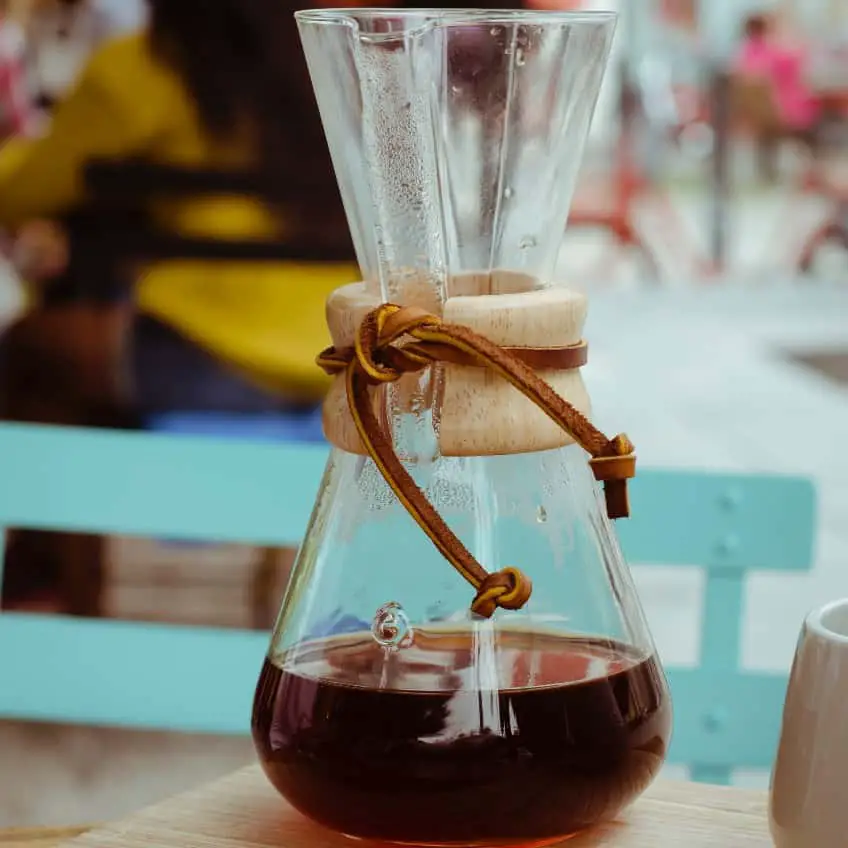
As a big fan of Chemex, I like the clarity that comes with using Chemex papers. The appeal and elegance of the classic Chemex decanter- the clear glass and shape, the wood, and the tie – keeps me loyal to this brewer.
However, sometimes the Chemex filters are in short supply. Having a reusable Chemex filter is handy to ensure that I continue making my daily cup of coffee with the Chemex carafe.
There are two types of reusable Chemex filters: fabric/sock filters and stainless steel filters. Fabric filters such as the coffee sock and the hemp cone filter yield lighter-bodied and brighter coffee without sediments.
On the other hand, metallic filters yield a coffee that has a bigger mouthfeel and more complex flavors. Metallic filters are likely to leak sediments into your coffee.
Why You Should Use a Reusable Chemex Filter
- Chemex reusable filters, metal and fabric, brew a more flavorful coffee and are a desirable choice when you prefer a fuller-bodied java
- They last longer and are more eco-friendly than paper. The fabric is biodegradable and the stainless steel is recyclable.
- Reusable filters for Chemex eliminate the need to keep replenishing your paper stocks
- They are cheaper to use. You buy once and use the filter over a long period of time
- Compatibility with other coffee makers. You can use the same reusable filter in other pour-over coffee makers such as bonavita and Hario V60
Types of Reusable Chemex Filter
1. Reusable Fabric/Sock Filter For Chemex
Here is a chart of the pros and cons of a seusable sock filter
| Pros | Cons | |
|---|---|---|
| 1 | Cheaper to buy | Requires regular thorough cleaning to avoid bad smell |
| 2 | Filters fine sediments out of your coffee | Needs extra care during storage to prevent molds (cotton sock) and bad smell |
| 3 | Coffee has more clarity than metallic filters | Easily susceptible to staining |
| 4 | Reusable over hundreds of times | Can introduce new undesirable flavors to the coffee if it’s not cleaned and stored properly |
| 5 | The fabric is biodegradable and eco-friendly | |
| 6 | Allows some oils into the coffee leading to more flavors and body than paper | |
| 7 | Hemp filter is mildew resistant |
The reusable hemp cone coffee filter is made from organic hemp that is biodegradable and functions similarly to the organic cotton coffee sock.
Metallic/ Stainless Steel Reusable Chemex Filters
Metalic coffee filters are made of stainless steel to resist high temperatures and corrosion. Here is a chart of the pros and cons of using a metallic filter in Chemex
| Pros | Cons | |
|---|---|---|
| 1 | Gives full bodied coffee with complex flavors | Not desirable for people who prefer clean coffee with more clarity |
| 2 | Easy to clean. Empty the used grounds and rinse in warm water | Allows coffee fines into the coffee |
| 3 | Easy to handle due to a solid structure | Higher risk of clogging |
| 4 | Does not require special storage | A foldable metal filter such as the Zulay filter can cumbersome to use and clean |
| 5 | Available in gold and copper colors that match with the wood on Chemex classic | |
| 6 | Dishwasher safe | |
| 7 | Resistant to corrosion and adds no external flavors to the coffee |
Reusable Metal Filter vs Paper Filters For Chemex
| Reusable Metal Filter | Chemex Paper Filter | |
|---|---|---|
| 1 | Allows oils into the coffee hence a bigger mouthfeel and body in the coffee | Filters oils and bitterness and yields coffee that has a lighter body |
| 2 | Allows micro-grounds into the coffee and the coffee is darker | Crisp clean coffee with more brightness |
| 3 | More economical to use and a single filter can last for more than a year | Relatively expensive and needs continuous replenishing |
| 4 | Easy to handle without the risk of tearing or collapsing on the spout | Requires careful handling to minimize chances of tearing and collapsing |
| 5 | Needs proper cleaning after every brewing cycle. Cleaning can be messy | They are single-use |
| 6 | Allows lots of oils, including unhealthy oils, into the coffee | Keeps unhealthy oils out |
| 7 | Multiple-use with other pour-over style brewers such as Bonavita and Hario V60 | Is single-use and not compatible with non-Chemex brewers |
Chemex 3 Cup Reusable Filter
The best reusable filter for the small-sized Chemex 3 cup carafe is the Zulay stainless steel filter. It fits in the carafe and brews a flavorful cup of coffee.
How To Use A Reusable Chemex Filter
Equipment and Materials
- a gooseneck kettle with temperature control
- a digital scale
- a reusable filter (metal or sock)
- a small measuring can
- a Chemex decanter
- a burr grinder
- filtered water
- coffee beans
- a teaspoon
Directions When Using A Chemex Reusable Filter
- Put the reusable filter in the Chemex decanter
- Measure the coffee beans at a ratio of 1:17 for example 30 grams of coffee to 500ml of water
- Heat the water to a temperature of about 205 degrees Fahrenheit
- Grind the measured beans to a medium-fine to medium grind size for the sock filter and a medium-coarse to coarse size for the metal filter
- Pour some hot water on the filter to flush the taste of the paper and to preheat the decanter
- Carefully pour out the water from the decanter without dropping the filter. You can also remove the filter and empty the decanter before replacing the filter
- Pour the fresh grounds on the filter and place the decanter on the digital scale
- Reset the scale’s timer to zero
- Pour the 205° F hot water carefully on the grounds in a circular motion while paying attention to the weight scale
- Stop when the scale reaches a weight that is about 2 to 3 times the original weight of the grounds. For example, if you are using 30 grams of grounds to make 500 ml of coffee. Then stop pouring at around the 60-90 grams stage for the grounds to bloom for 30 to 45 seconds. Blooming is when the grounds release CO2 to allow optimum extraction.
- Stir the grounds or swirl the decanter to even the flow of water until there are no lumps
- Slowly pour water in a circular motion to maintain an even bed of grounds and until the waiter rises on the filter.
- Stop pouring and agitate the grounds with a spoon
- Continue slowly pouring until you reach the desired weight, for example, 500 ml
- Leave the filter to continue filtering. The filter will finish at between 2.5 to 4.5 minutes depending on the size of your grind.
- Dump the grounds in a trash can and rinse the filter in warm water
- Hang the sock filter to dry. If you are using a metal filter, place it on a drying dish rack
- Pour the coffee in a cup and sip on it
Important Tip
Avoid transfering the hot water from the heating kettle to another kettle before pouring in the Chemex because the water temperature will fall during the transfer. The decrease in temperature can cause underextraction.
Commonly Asked Questions
Can I Use A Paper Filter In A Permanent Filter
Yes, you can fit a paper filter in a permanent filter to brew your coffee. Regular filters such as the Melitta #4 break easily, especially, when brewing bigger cups in Chemex. Fitting the paper filter in the permanent filter prevents the paper from collapsing or breaking under the weight of the grounds and water.
However, using two filters results in double filtration and can slow down the extraction process. You are better off using original robust Chemex paper filters or a reusable filter than pairing two filters together.
